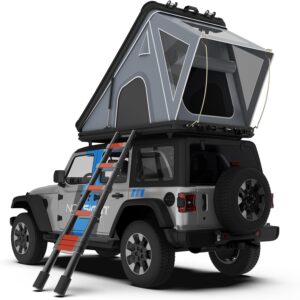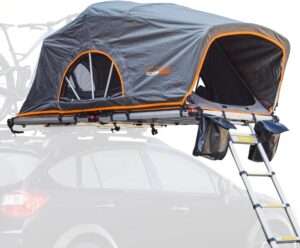How Much Weight Can A Rooftop Tent Support?
Have you ever wondered how much weight a rooftop tent can actually hold? Whether you’re planning a camping trip or considering purchasing a rooftop tent, it’s important to know its weight capacity to ensure safety and functionality. In this article, we will discuss the factors that determine a rooftop tent’s weight limit, how to calculate the weight capacity, and tips for maximizing the tent’s durability and safety. Let’s dive in!
Factors that Determine a Rooftop Tent’s Weight Limit
When it comes to determining the weight capacity of a rooftop tent, there are several factors to consider. These factors include the tent’s design and construction, the type of vehicle it will be mounted on, and the weight distribution of the occupants and gear inside the tent. Let’s break down each of these factors to understand how they impact a rooftop tent’s weight limit.
Design and Construction of the Rooftop Tent
The design and construction of a rooftop tent play a significant role in determining its weight limit. Generally, rooftop tents are made of durable materials such as aluminum or fiberglass to withstand the weight of the occupants and gear. The tent’s frame, base, and cover are designed to provide stability and support while minimizing the overall weight of the tent itself.
Type of Vehicle
Another factor that influences a rooftop tent’s weight limit is the type of vehicle it will be mounted on. The rooftop tent must be compatible with the vehicle’s roof rack system and have proper mounting hardware to ensure a secure fit. The weight capacity of the vehicle’s roof rack system will also impact the overall weight limit of the rooftop tent. It is essential to consult the vehicle’s manufacturer guidelines to determine the maximum weight that the roof rack can support.
Weight Distribution of Occupants and Gear
The weight distribution of the occupants and gear inside the rooftop tent is crucial to its overall weight capacity. Distributing weight evenly and within the specified limits will prevent strain on the tent’s frame and base. It is recommended to check the manufacturer’s guidelines on weight distribution and limitations to ensure that the rooftop tent can support the combined weight of the occupants and their gear.
Calculating the Weight Capacity of a Rooftop Tent
To calculate the weight capacity of a rooftop tent, you will need to consider the following factors:
- The tent’s maximum load rating provided by the manufacturer.
- The weight of the occupants and gear inside the tent.
- The weight of the rooftop tent itself.
Here’s a simple formula to help you calculate the weight capacity of a rooftop tent:
Weight Capacity (lbs) = Maximum Load Rating (lbs) – Weight of Rooftop Tent (lbs) – Weight of Occupants and Gear (lbs)
By subtracting the weight of the rooftop tent and the occupants and gear from the maximum load rating provided by the manufacturer, you can determine the weight capacity of the rooftop tent. It is essential to stay within the weight capacity limits to prevent damage to the tent and ensure the safety of the occupants.
Tips for Maximizing a Rooftop Tent’s Durability and Safety
To maximize the durability and safety of a rooftop tent, consider the following tips:
Regular Inspection and Maintenance
Inspect the rooftop tent regularly for any signs of wear and tear, such as loose bolts, torn fabric, or damaged zippers. Perform routine maintenance and repairs as needed to ensure the tent’s structural integrity and stability while in use.
Proper Installation and Mounting
Follow the manufacturer’s instructions for installation and mounting the rooftop tent on your vehicle’s roof rack system. Use the recommended hardware and tools to secure the tent in place and check for any loose or missing components before each use.
Distribute Weight Evenly
Distribute the weight of the occupants and gear inside the rooftop tent evenly to prevent strain on the tent’s frame and base. Keep in mind the weight capacity limits provided by the manufacturer and avoid exceeding them to maintain the tent’s stability and safety.
Avoid Overloading the Rooftop Tent
Avoid overloading the rooftop tent with excessive weight beyond its capacity limits. Check the maximum load rating provided by the manufacturer and stay within the specified limits to prevent damage to the tent and ensure the safety of the occupants.
Secure the Tent during Transportation
Ensure that the rooftop tent is securely closed and latched before driving to prevent it from opening or shifting during transportation. Check the mounting hardware and roof rack system regularly to ensure a secure fit and stability while on the road.
Store the Tent Properly when not in Use
Store the rooftop tent properly when not in use to protect it from the elements and prolong its lifespan. Use a protective cover or storage bag to shield the tent from dirt, dust, and UV rays, and store it in a dry and secure location to prevent damage.
Conclusion
In conclusion, the weight capacity of a rooftop tent is determined by various factors, including its design and construction, the type of vehicle it will be mounted on, and the weight distribution of the occupants and gear inside the tent. By calculating the weight capacity and following the tips for maximizing durability and safety, you can ensure a safe and comfortable camping experience with your rooftop tent. Remember to prioritize safety and adherence to the manufacturer’s guidelines to prevent damage and ensure a memorable outdoor adventure.




